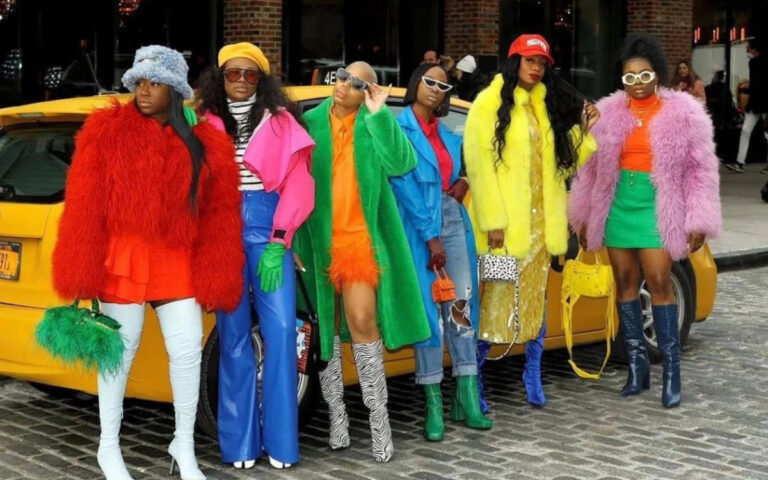Conscious Colour Theory: How to Use Your Season to Your Advantage
Cora Gold
Colour theory is the latest in a string of fashion trends that is blowing up on social media this year. While some may see it as another passing fad, it can actually be a useful tool in building a sustainable wardrobe. Discovering your “season” and finding the right blend of hues that flatter your complexion are keys to avoiding waste and making sustainable choices. Here’s how to use colour theory more consciously when you’re shopping.

Conscious Colour Theory Explained
This year, colour theory became a huge trend on TikTok, inspiring people to use filters and even hire professionals to determine their colour season — whether it be fall, winter, summer or spring. On TikTok, you can find a filter that puts the different colour palettes around your face and click through them to see which one makes your complexion even and your eyes pop. It can help you figure out if you look best in muted tones, like fall or spring, or vibrant tones, like winter or summer.
Like many fashion trends, colour theory may lead people to buy more clothes and discard old items. However, colour theory can actually be used to reduce your consumption if you apply it more thoughtfully.
Conscious colour theory marries an understanding of the psychology of colour with sustainable practices. Colour psychology concerns itself with how the human mind reacts to various hues, the feelings that certain tones and shades inspire in the heart.
Colour theory also refers to which hues flatter various complexions the best. You can take an online assessment alone or with a friend to determine your season — which defines the tones and shades that suit you best. Various factors contribute to your season, from your underlying skin tone to your hair colour and even your personality.
Conscious colour theory means taking what you’ve learned about the hues that suit you best and using that knowledge to craft a wardrobe that treads lightly on the planet.
Now, you can still wear whatever colours you want. If your favourite shade of blue isn’t in your colour wheel, don’t let that stop you. What you should pay attention to instead is what colours make you feel confident. Many of us probably have a piece that still has tags on it because we just don’t like how it looks on. Shopping for your season can help avoid those impulse buys and curate a closet that you love.
Being conscious of your choices can save you money, as well. For example, pops of red have been on trend this fall, but that doesn’t mean you need to go buy those red ballet flats you’ve seen all over Pinterest. If red won’t fit in with your wardrobe, save yourself from spending money on something you’ll never wear.
@withlovejaye Heres your proof to learn what colors work best for your skin because color theory is real #colortheory #colortheoryfoundation #colortheorymakeup #blackwomenincolor #fyp #foryou ♬ Motivational Piano - StudioKolomna
4 Ideas for Using Colour Theory to Rock Every Season
Now that you understand what conscious colour theory is, here’s how you can use it to rock your wardrobe.
1. Choose a Signature Colour
Choosing a signature colour unites your wardrobe, creating a unifying theme throughout that lets you mix and match pieces with ease. You should select a shade that can run the gamut, from bright fluorescents to muted pastels.
Your signature colour should also complement the neutral hues you prefer. For example, pink looks quite different against tans and khakis than it does against blacks, greys and whites. However, you can make any neutral tones work. Suppose you are an “autumn” who likes pink. Instead of opting for a bright white beneath that midi sweater, opt for an eggshell or off-white to flatter your warmer skin tone.
2. What’s Old Is New
So, you’ve figured out what your colour season is and realised half your wardrobe doesn’t suit you. What now?
What you don’t want to do is throw everything out. In the UK, around 350,000 tonnes of clothing is sent to landfills each year. Consider smarter options before tossing out your unwanted pieces:
- Donate pieces in good condition to charity shops or non profit organisations (we love Give Your Best).
- Host a clothing swap with friends. Make a fun night of doing each others’ colour analysis, then trade clothes that will work better on your friends.
- Repurpose the material. If you know how to knit or crochet, you can unravel old sweaters and use the yarn to make something new. You can also use fabric to make bags or other accessories.
When you do purchase new items, prioritise shopping secondhand or investing in high quality items from sustainable brands.
3. Accessorise for the Win
Accessories can make or break an outfit, and discovering your season helps you select pieces that work with your complexion and signature colour. For example, spring and autumn people with warm undertones look best in gold, rose gold and copper, with amber, green and turquoise gemstones. Winter and summer folks look best in silver, platinum and white gold with amethyst, ruby or sapphire jewels.
Remember, jewellery isn’t the only way to accessorise. Scarves, hats, sashes and even ties can bring new life to an old outfit.
4. Learn to Layer
Although layering your clothes isn’t strictly a conscious colour theory technique, doing so keeps you looking your best no matter how the temperature changes throughout the day. This practice is not solely limited to the outdoors — use this idea to stay comfy in the office, too. To layer your clothes effectively:
- Choose a wicking base layer that keeps sweat away.
- Select a middle layer for insulation, such as a vest with a sweater.
- Wear an outer layer that protects against wind and rain.
Make the most out of your new conscious colour theory skills; and by identifying your best shades, you prevent unnecessary waste while crafting a signature wardrobe.
Author bio: Cora Gold is a sustainable living writer and editor of women’s lifestyle magazine, Revivalist. She loves to write about eco-friendly fashion, beauty and home inspiration. Connect with Cora on LinkedIn, Pinterest and X.




